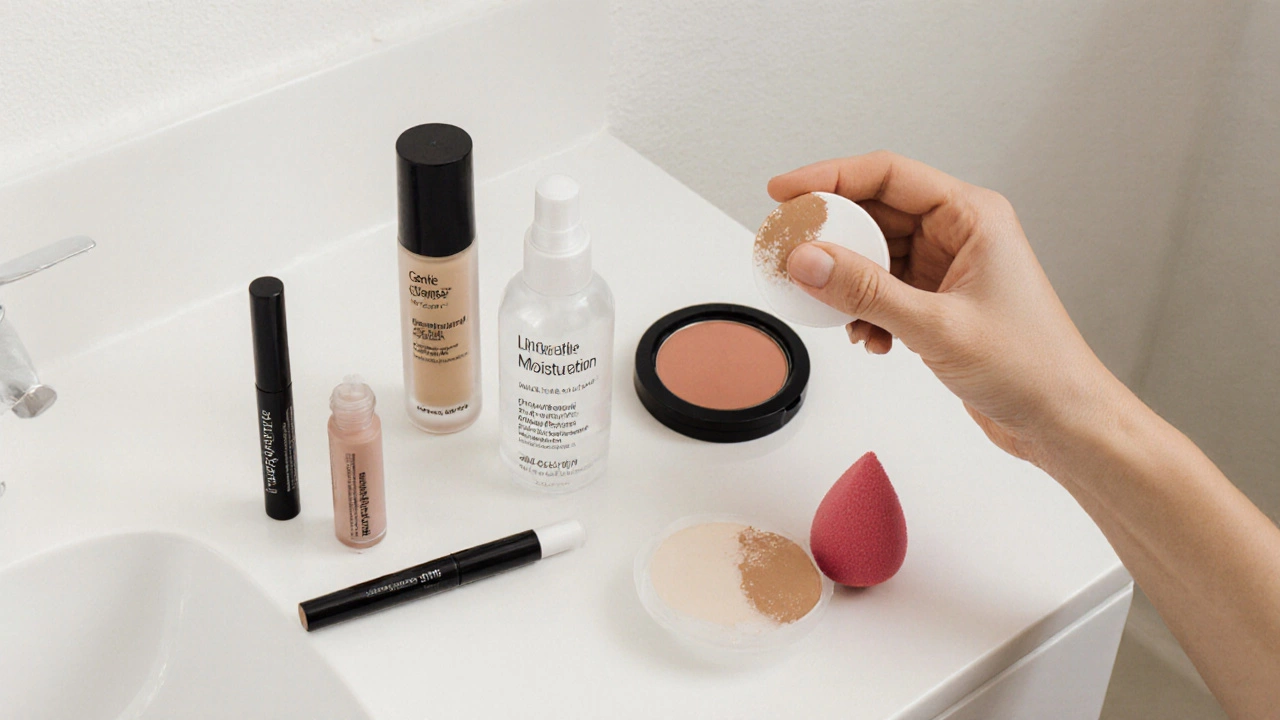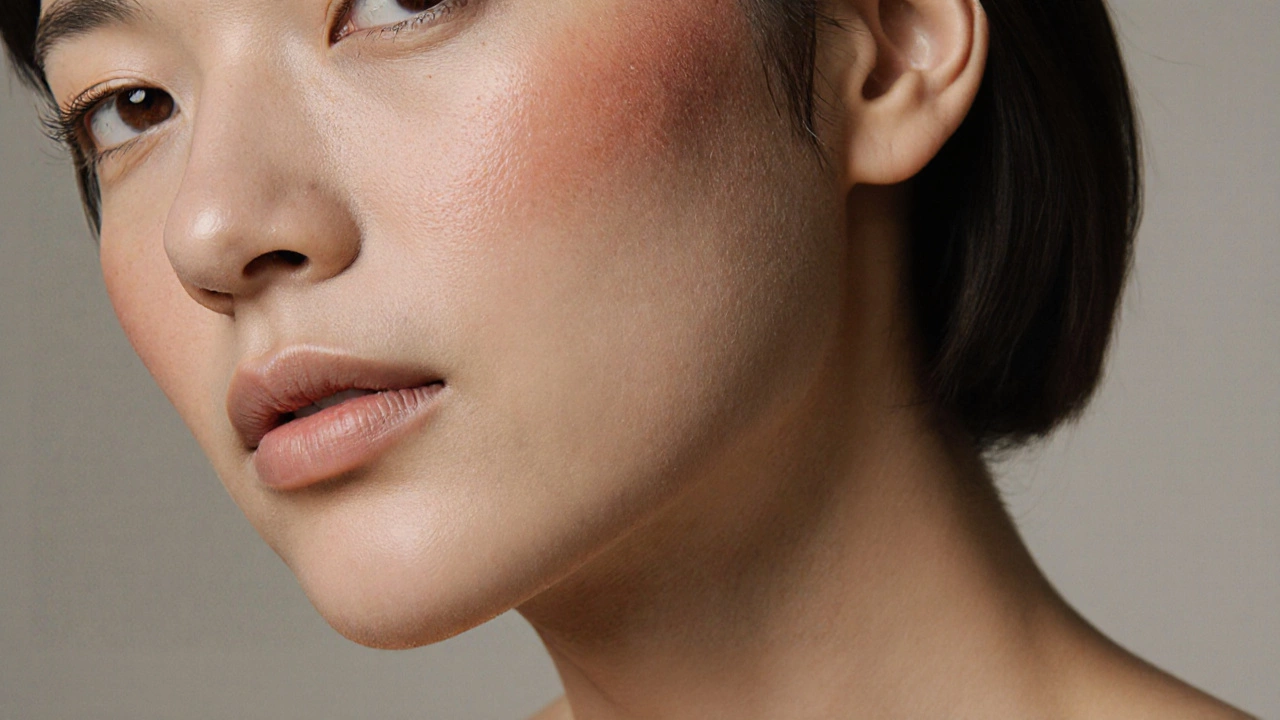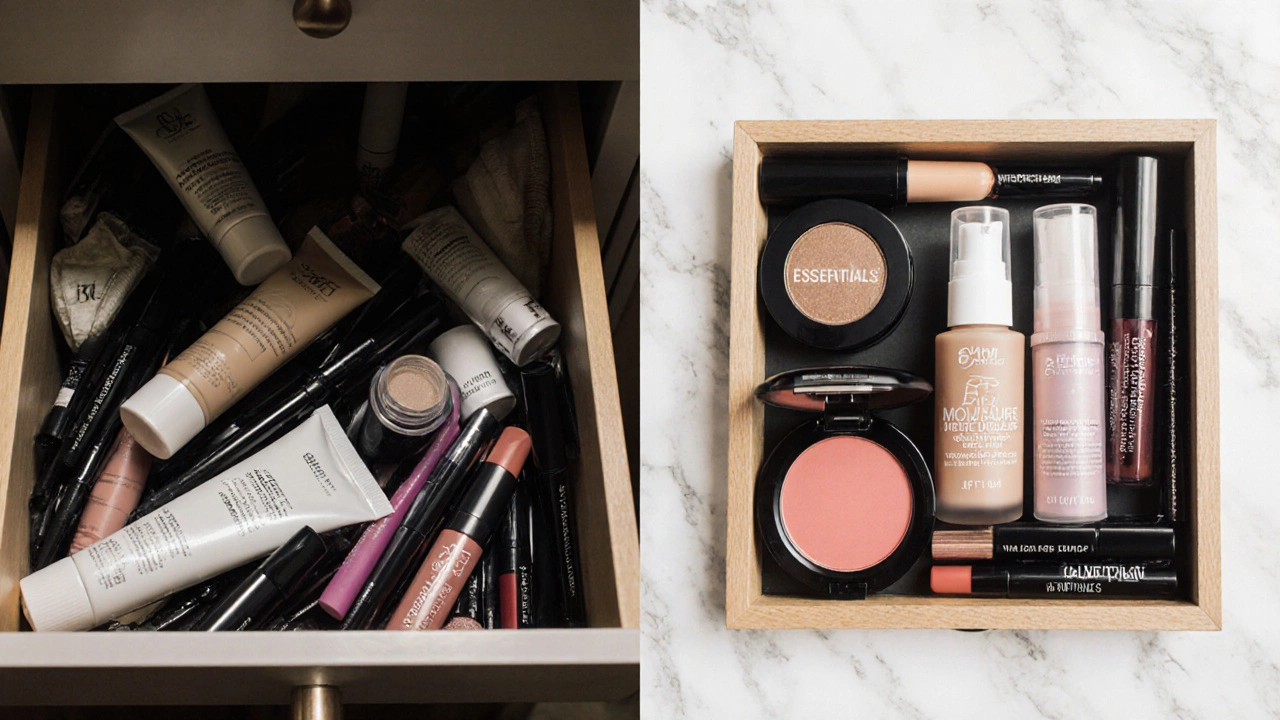
Minimalist Makeup Checklist
Create Your Personalized Routine
Answer a few questions to get a customized list of products you actually need
Ever looked in the mirror and felt like you’re missing something-even though your bathroom shelf is full of products? You’re not alone. Most people think they need a dozen items for a good makeup routine, but the truth is simpler. You don’t need a full cosmetic counter. You just need the right few things that work for your skin, your schedule, and your style.
Start with Skin Prep
Makeup sits on top of your skin. If your skin is dry, flaky, or oily, no amount of foundation will fix it. That’s why skin prep isn’t optional-it’s the base of everything.
Begin with a gentle cleanser. You don’t need anything fancy. A simple water-based cleanser that doesn’t strip your skin works fine. Wash your face in the morning, even if you didn’t wear makeup the night before. Your skin collects oil, sweat, and pollution while you sleep.
Next, apply a lightweight moisturizer. If you have oily skin, go for a gel-based one. If your skin feels tight or flaky, pick a cream with hyaluronic acid or ceramides. Let it sink in for a full two minutes before moving on. Skipping this step causes makeup to cake, crack, or slide off by noon.
Then comes sunscreen. Yes, even if it’s cloudy. UV rays damage skin and make makeup look dull faster. Look for a broad-spectrum SPF 30 or higher that’s labeled "non-comedogenic" so it won’t clog pores. Many tinted moisturizers now include SPF, which saves time.
Even Out Your Skin Tone
Foundation isn’t always necessary, but most people benefit from something to even out redness, dark spots, or uneven tone. You don’t need full coverage unless you’re going for a photo-ready look.
A tinted moisturizer or BB cream works great for everyday wear. They give light coverage while hydrating your skin. If you need a little more coverage, try a liquid foundation with a natural finish. Avoid heavy, matte formulas unless you have oily skin-they can look mask-like after a few hours.
Apply with your fingers or a damp sponge. Fingers warm up the product and blend it naturally. Sponges give a smoother finish if you want a more polished look. Don’t forget your neck and ears. A mismatched face and neck is the quickest giveaway of poorly applied makeup.
Conceal What Matters
Don’t reach for concealer just because you see a blemish. Use it strategically. The best places to apply concealer are under your eyes and on any red spots or dark circles.
Choose a shade that matches your skin tone exactly-or one shade lighter under the eyes. Too light creates a ghostly effect. Too dark looks like a shadow. Dab a small amount with your ring finger and gently pat it in. Don’t rub. Rubbing pulls at delicate skin and makes lines worse.
If you have dark circles that won’t fade, a peach or orange-based color corrector under your concealer can neutralize blue tones. But only use this if you need it. Many people skip it entirely and still look great.
Set It and Forget It
Setting powder keeps your makeup from sliding off. You don’t need to dust your whole face. Focus on the T-zone-forehead, nose, and chin-where oil builds up fastest.
Use a translucent powder. It won’t change your skin tone. A fluffy brush or a puff works fine. Press lightly. Too much powder looks chalky and makes skin look older. If you have dry skin, skip powder on your cheeks and just use a setting spray instead.
Setting sprays are great for locking everything in. They add a soft finish and help makeup last longer. Look for ones with hydrating ingredients like aloe or glycerin. Avoid alcohol-heavy sprays-they dry out your skin and make makeup crack.

Add a Touch of Color
Color is what makes makeup feel finished. But you don’t need a rainbow. Three products are enough: blush, lip color, and mascara.
Blush gives life to your face. Cream blushes blend easily and look natural. Pick a shade that mimics your natural flush-peach for warm skin tones, rose for cool tones. Smile and dab it on the apples of your cheeks. Blend upward toward your temples.
Lips don’t need a full lipstick. A tinted balm, a stain, or a sheer gloss works perfectly for daily wear. Choose a color close to your natural lip tone. Too bold can look out of place unless you’re dressing up. If you want more definition, use a lip liner that matches your lipstick-or just your natural lip color.
Mascara is the easiest way to wake up your eyes. Black or brown works depending on your hair color. Waterproof isn’t necessary unless you cry easily or live in a humid place. One coat is often enough. Two coats can clump. Wiggle the wand at the base of your lashes and pull through. Don’t pump the wand in the tube-it dries out the formula faster.
Optional but Helpful Extras
Once you’ve mastered the basics, you can add a few extras if you want more control or definition.
Brow pencil or gel helps shape your eyebrows. You don’t need perfect lines. Just fill in sparse spots with light, hair-like strokes. Too dark or too sharp looks unnatural.
Highlighter adds a glow. Use it sparingly-on the high points of your face: cheekbones, brow bone, bridge of the nose. A liquid or cream highlighter blends better than powder for everyday wear.
Setting spray with a hint of shimmer can give your skin a healthy radiance without looking glittery. It’s a great substitute for highlighter if you want less hassle.
What to Skip
There are a lot of products marketed as "must-haves." Most aren’t.
Primer? Only if your makeup slides off in under two hours. Many modern foundations don’t need it.
Contour? Unless you’re doing a full glam look, skip it. It’s easy to overdo and looks muddy in natural light.
Eye shadow? You don’t need more than one shade. A neutral brown or taupe on the lid adds depth without effort. Avoid glitter or bright colors unless it’s a special occasion.
Makeup brushes? You can do everything with your fingers and a sponge. Brushes are nice, but they’re not essential. Clean them weekly if you use them.

Your Minimalist Makeup Routine
Here’s what you actually need for a simple, effective daily routine:
- cleanser
- moisturizer
- sunscreen
- tinted moisturizer or light foundation
- concealer
- translucent setting powder
- setting spray
- cream blush
- lip tint or balm
- mascara
That’s ten products. Nothing more. You can do this in five minutes. And you’ll look like you didn’t try too hard-which is exactly what good makeup should do.
How Often Should You Replace Products?
Makeup expires. Using old products can cause breakouts or infections.
Liquid foundation and concealer: Replace every 6-12 months
Mascara: Replace every 3 months-yes, really. Bacteria grows fast in the tube
Lipstick and lip gloss: Last 1-2 years
Blush and powder: Last 2 years if kept clean
Brushes and sponges: Wash weekly. Replace sponges every 1-3 months. Brushes can last years if cleaned regularly.
Write the date you opened each product on the bottom with a marker. It’s a small habit that saves your skin.
Final Thought: Less Is More
The goal of makeup isn’t to hide your face. It’s to enhance it. The best routine is the one you actually stick to. If you’re rushing out the door, you want something quick, reliable, and forgiving.
Start with the ten essentials. Master them. Then, if you want to add more, do it slowly. Don’t buy something just because it’s trending. Buy what your skin needs. And remember-your natural skin, when cared for, looks better than any filter ever could.
Do I need primer for my makeup routine?
No, you don’t need primer unless your makeup doesn’t stay on. Most modern foundations and tinted moisturizers are designed to stick to skin without extra help. If your skin is oily and your foundation slides off by lunch, then a lightweight, oil-free primer might help. But for most people, good skin prep-cleansing, moisturizing, and sunscreen-is enough.
Can I use the same products for day and night?
Yes, absolutely. The same foundation, concealer, blush, and mascara you use during the day work fine at night. For evening, you can add a deeper lip color or a second coat of mascara if you want more drama. But there’s no need to buy separate products. Your daytime routine can easily transition to night with small tweaks.
What if I have sensitive skin?
Look for products labeled "hypoallergenic," "fragrance-free," and "non-comedogenic." Avoid anything with alcohol, essential oils, or harsh preservatives. Stick to brands made for sensitive skin-CeraVe, Vanicream, and La Roche-Posay are good starting points. Patch test new products on your jawline for a few days before using them all over your face.
Is it okay to wear makeup every day?
Yes, as long as you remove it every night and keep your skin healthy. Washing your face before bed and using gentle, non-drying products prevents clogged pores and breakouts. If you notice redness, itching, or dryness, take a day or two off. Let your skin breathe. Makeup isn’t harmful-it’s the poor habits around it that cause problems.
How do I pick the right foundation shade?
Test foundation on your jawline, not your hand. Lighting matters-do it in natural daylight if possible. The right shade disappears into your skin. If you see a line where your face ends and your neck begins, it’s too light or too dark. Many brands now offer online shade match tools. Or ask for samples at a store and wear them for a full day before deciding.
Next Steps
Start by clearing your makeup drawer. Take out everything you’ve used in the last six months. Keep only what you reach for regularly. Then build your routine around those ten essentials. Buy one new product at a time-don’t overwhelm yourself.
Pay attention to how your skin feels. Does your foundation feel heavy? Try a lighter one. Does your blush look too bold? Switch to a cream version. Your routine should adapt to you-not the other way around.
Remember: Makeup is a tool, not a requirement. You don’t need it to be beautiful. But if you enjoy wearing it, keep it simple. You’ll look better, feel more confident, and spend less time-and money-on things you don’t really need.
 Hair Care
Hair Care